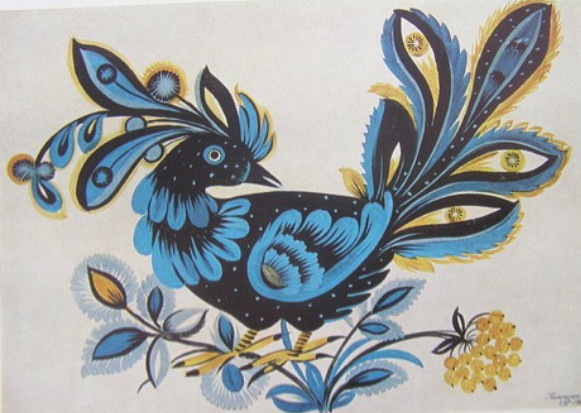Petrykivka painting
Petrykivka painting (Петриківський розпис; Petrykivskyi rozpys). The name given to folk painting on the whitewashed walls of peasant houses. Petrykivka painting is now an independent decorative art form. Its name derives from the village of Petrykivka, near Dnipro, which in the 19th century became the center of this type of painting and produced several of the better-known folk artists. The artists create stylized floral and plant motifs arranged in two basic types of compositions, kvity (flowers) of bouquets and bihuntsi (runners) of friezes. Originally these designs were used to decorate traditional stoves, the main wall of the house, and the frames of windows and doors. Chalk, local clays, soot, and paints produced from plants and bound with egg yolk, milk, or cherry glue were used to execute the decorations. As the demand for such decorations increased, village artists started producing malovky. Sold at local farm markets, these designs were painted on transparent or semitransparent paper that could be attached to walls. Eventually the decorations became independent pictures created on paper with tempera pigments. In 1936 a special art school was established in Petrykivka.
The four brush strokes traditional in the Petrykivka painting designs are: (1) hrebinchyk (comb), which begins with pressure and ends in a wisp and is used for flowers, leaves, and grasses with rounded shapes; (2) zerniatko (seed), which begins with a light touch and ends with full pressure of the brush and is used for leaves with jagged edges; (3) horishok (nut), a variant of hrebinchyk, which is used to depict the flower pistils and buds; and (4) a transitional stroke in which the brush is dipped in several pigments, which is used for painting flower petals and leaves requiring tonal shading. Traditionally the painting is done with a cat’s-hair brush directly on paper without any preliminary drawing.
Some of the better-known artists of the Petrykivka school of painting have been Tetiana Pata, Marfa Tymchenko, N. Bilokin, O. Pylypenko, H. Isaieva, V. Klymenko, Paraskeviia Pavlenko, V. Pavlenko, Hanna Pavlenko-Chernychenko, V. Kucherenko, M. Shyshatska, F. Panko, P. Hlushchenko, N. Shulyk, and Z. Kudish.
Daria Zelska-Darevych
[This article originally appeared in the Encyclopedia of Ukraine, vol. 3 (1993).]
.jpg)

.jpg)

.jpg)